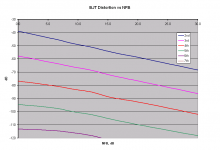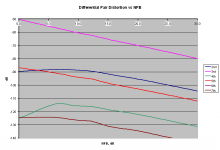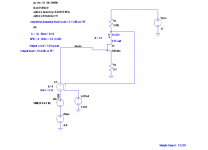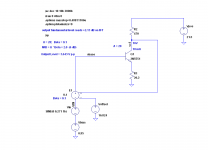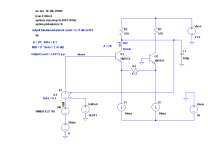BJT distortion as a function of NFB
Here are the results of my simulation of the distortion of a single-ended BJT as a function of amount of NFB. Note that distortion decreases monotonically from the get-go, for all harmonics.
Note also that this is for a BJT operating at 10 mA with an emitter resistor of 20 ohms and a gain of 20. Its open-loop gain of 20 is slightly greater than was the gain of the single-ended JFET stage, whose open-loop gain was 14.
It is producing an output of 3.6 V p-p and a second harmonic distortion level of -36 dB (1.6%) when there is no NFB.
Cheers,
Bob
Here are the results of my simulation of the distortion of a single-ended BJT as a function of amount of NFB. Note that distortion decreases monotonically from the get-go, for all harmonics.
Note also that this is for a BJT operating at 10 mA with an emitter resistor of 20 ohms and a gain of 20. Its open-loop gain of 20 is slightly greater than was the gain of the single-ended JFET stage, whose open-loop gain was 14.
It is producing an output of 3.6 V p-p and a second harmonic distortion level of -36 dB (1.6%) when there is no NFB.
Cheers,
Bob
Attachments
BJT Differential Pair distortion vs NFB
Here are the results for the BJT differential pair. It has the same gain and output voltage (to one collector) as the earlier single-ended BJT example.
Note that there is some evidence of NFB increasing the level of the fourth harmonic, which started out at an extremely low level of -124 dB and grew to -114 dB at a feedback level of 6 dB.
Bob
Here are the results for the BJT differential pair. It has the same gain and output voltage (to one collector) as the earlier single-ended BJT example.
Note that there is some evidence of NFB increasing the level of the fourth harmonic, which started out at an extremely low level of -124 dB and grew to -114 dB at a feedback level of 6 dB.
Bob
Attachments
dimitri said:
No, he did this also for BJT in the last paper of the series, Feb next year
Please check your simulution as Baxandall _measured_ results for BJT exhibit enhancement of harmonics as NFB was applied
Further reading:
www.its.caltech.edu/~musiclab/ feedback-paper-acrobat.pdf
Hi Dimitri,
I was unaware of his further work. Please email me a copy of it at bob@cordellaudio.com. I'll take a look at it and try to see why there might be a discrepency.
Thanks,
Bob
Folks,
it was so nice time when we were young (really long ago). We had mediocre measuring methods and almost no simulation software. But that plenty of time we had for phoney excuses and superstitions!!
it was so nice time when we were young (really long ago). We had mediocre measuring methods and almost no simulation software. But that plenty of time we had for phoney excuses and superstitions!!

Bob's circuit has emitter degeneration of a little less than 7.8 times re, while Baxandall's has no degeneration at all. It's not clear that these plots should look the same. It's not an apples-to-apples comparison.
Edit: Dimitri, I found part 6 of the Baxandall article - no need to send it. Thanks.
Edit: Dimitri, I found part 6 of the Baxandall article - no need to send it. Thanks.
Thinking about this a bit more, you could think of the emitter resistor as providing a local feedback loop with local loop gain gm*RE. This gives 20*log(20.2/2.6) = 17.8 dB local feedback, before any global feedback has been applied.
john curl said:Something appears to be wrong with the bipolar 3rd harmonic plot.
Hi John,
Can you be a bit more specific?
Thanks,
Bob
Re: BJT distortion as a function of NFB
Hi Dimitri,
It looks like you are comparing Baxandall's measured results here with my simulated results (I don't think Baxandall did any simulations). I presume this is from the Baxandall article part that I don't have. I also notice that the schematic of his arrangement in your post below does not include any emitter degeneration, as mine did. It is possible that this difference accounts for the different results.
I'll give the simulations a try without emitter degeneration and see if the results differ that way.
If the differences between my results and Baxandall's results are due to emitter degeneration, then questioning the "fairness" of my inclusion of emitter degeneration is a fair question.
Its a good subject for further discussion.
I chose the emitter degeneration so that I would be comparing a bipolar stage with an amount of gain in roughly the same neighborhood as that of the JFET example.
I suppose that one could argue that my results are perhaps inapplicable to an undegenerated stage, such as an undegenerated VAS.
But I could argue on the other hand that in most realistic situations, people tend to use amounts of degeneration not dissimilar to what I have used with these bipolars.
If the result was that you never have to worry about feedback enhancement of distortion with bipolars as long as you use at least some modest amount of degeneration, I'd sure be happy.
There is another possibility. If the simulation without degeneration does not show results similar to Baxandall's measured results, we then must allow for two possibilities:
First, that his use of electrolytic bypass capacitors in the emitter circuit is contributing some distortion; Second, that the SPICE simulation for some reason is not faithfully capturing what is going on there. A duplication of Baxandall's lab measurements might then be called for to sort out the real answer.
Thanks for this info.
Cheers,
Bob
dimitri said:This is the example how far the simulation can be from reality
Hi Dimitri,
It looks like you are comparing Baxandall's measured results here with my simulated results (I don't think Baxandall did any simulations). I presume this is from the Baxandall article part that I don't have. I also notice that the schematic of his arrangement in your post below does not include any emitter degeneration, as mine did. It is possible that this difference accounts for the different results.
I'll give the simulations a try without emitter degeneration and see if the results differ that way.
If the differences between my results and Baxandall's results are due to emitter degeneration, then questioning the "fairness" of my inclusion of emitter degeneration is a fair question.
Its a good subject for further discussion.
I chose the emitter degeneration so that I would be comparing a bipolar stage with an amount of gain in roughly the same neighborhood as that of the JFET example.
I suppose that one could argue that my results are perhaps inapplicable to an undegenerated stage, such as an undegenerated VAS.
But I could argue on the other hand that in most realistic situations, people tend to use amounts of degeneration not dissimilar to what I have used with these bipolars.
If the result was that you never have to worry about feedback enhancement of distortion with bipolars as long as you use at least some modest amount of degeneration, I'd sure be happy.
There is another possibility. If the simulation without degeneration does not show results similar to Baxandall's measured results, we then must allow for two possibilities:
First, that his use of electrolytic bypass capacitors in the emitter circuit is contributing some distortion; Second, that the SPICE simulation for some reason is not faithfully capturing what is going on there. A duplication of Baxandall's lab measurements might then be called for to sort out the real answer.
Thanks for this info.
Cheers,
Bob
john curl said:Isn't SPICE great?
Hold your horses, John. All the information is not in yet.
SPICE is great, but it is not perfect. Until now, I myself have not relied on it for distortion stuff, either, so this part of it is a new adventure for me as well. So far, I'm pretty impressed, though.
Stay tuned. In the meantime, keep using your emitter degeneration 🙂.
Bob
andy_c said:Thinking about this a bit more, you could think of the emitter resistor as providing a local feedback loop with local loop gain gm*RE. This gives 20*log(20.2/2.6) = 17.8 dB local feedback, before any global feedback has been applied.
Hi Andy,
Very interesting point. Looking at it that way, one could argue that the 18 dB of local degeneration gets us past the "bad" part of the NFB degree spectrum, out to where it is good.
I'll try some more sims to see if that makes sense.
Thanks again for all your help with using the SPICE Fourier analysis capability.
Cheers,
Bob
- Home
- Amplifiers
- Solid State
- Bob Cordell Interview: Negative Feedback
